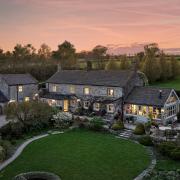Bawtry is the southern most town in Yorkshire and is bordered by Nottinghamshire and Lincolnshire. Janette Sykes takes a look around PHOTOGRAPHS BY GRAHAM LINDLEY
With its genteel Georgian facades, specialist shops and pleasant places to eat and drink, the elegant South Yorkshire town of Bawtry is a popular destination for a relaxing day or evening out.
Fewer coach parties may pause for a comfort break and stroll round on their way to East Coast seaside resorts such as Cleethorpes, Skegness and Mablethorpe, but plenty of visitors still stop to buy everything from diamonds to designer wear and to dine out and drink in style.
Stylish, cafes, tea rooms, hotels and pubs satisfy all pockets and palates during the day, while in the evening welcoming wine bars and restaurants add to the mouthwatering mix, with a variety of venues serving Modern British, Chinese, Indian, Italian and Japanese cuisine.
Shopping is also a stress-free experience in Bawtry, thanks to its wide High Street and Market Hill - now part of a Conservation Area, array of small, upmarket shops and thoughtfully-planned shopping areas such as The Courtyard and Dower House Square.
As well as everyday items, such as meat, bread and cakes and fresh fruit and vegetables from a stall outside the former town hall, now a colourful florist and plant shop, browsers can buy anything from quality clothes and specialist whiskies to antiques and unusual gifts.
Deriving from the Old English 'Baltry', its name is thought to mean 'tree rounded like a ball' or 'Balda's tree', and its origins can be traced back at least to Roman times, when it lay across the route from Lincoln to York. There were several Roman military camps in the area, and the legions are thought to have crossed the River Idle close to where the stone bridge on Gainsborough Road now stands.
Close to the boundaries of three counties - Yorkshire, Nottinghamshire and Lincolnshire - and situated where two major routes, one from north to south, known as the Great North Road, and the other from east to west, it is little wonder that transport has played such a pivotal role in Bawtry's fortunes over the centuries.
Seventy years ago, Ella Pontefract and Marie Hartley claimed in their 'Yorkshire Tour' that 'Bawtry says "Hail" and "Farewell" to Yorkshire people, welcoming them home if they come north and leading them to fresh sights and adventures if they go south'. That is certainly true for those travelling north from Nottinghamshire on the A614, for the first sight they will see on the left, on an imposing row of Georgian houses on South Parade, is a dark blue door and the unique, eyecatching address 'No. 1 Yorkshire'.
The town, once known as the Gateway to the North, first came to prominence as an inland port in the 12th century, thanks to the Idle, a tributary of the river Trent, and was granted its charter in 1213. In medieval times, roads were so bad that rivers were the preferred form of transport, and by the 14th century, Bawtry was a well-established river port.
'The river was very influential in the development of the town, and it is said that the stone that was used to build Roche Abbey was brought here,' said Bawtry-born Vivienne Wilcox, a former teacher and shopkeeper who is now vice chairman of the town council.
However, by the late 18th century, traffic bound for the Trent and Humber was rerouted on to the newly-opened Chesterfield Canal, and the roads had improved to such an extent that Bawtry became a major stopping stage for horse drawn coaches. This continued until the arrival of the railways and the main line between London and Edinburgh, which has given the town a new lease of life as a sought-after base for commuters, many travelling to Doncaster and Sheffield, and others as far as London.
The area is also associated with air travel, both civilian and military. Not only was 18th century Bawtry Hall, now a Christian conference centre, headquarters for RAF Group 1 Bomber Command from 1941 to 1984, the former RAF Finningley is now Robin Hood Airport, though Vivienne, town council chairman George Spencer and their 11 colleagues have reservations about current plans to extend night flights.
Transport, it seems, will remain a live local issue in the future.


























